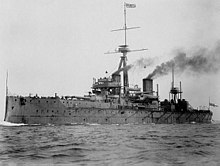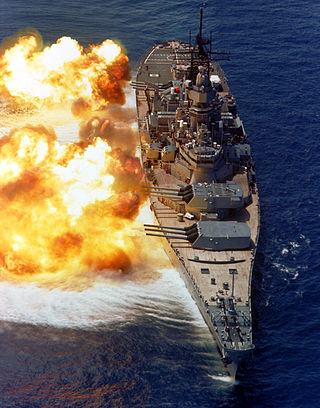
A battleship is a large, heavily armored warship with a main battery consisting of large-caliber guns, designed to serve as capital ships with the most intense firepower. Before the rise of supercarriers, battleships were among the largest and most formidable weapon systems ever built.

The Connecticut class of pre-dreadnought battleships were the penultimate class of the type built for the United States Navy. The class comprised six ships: Connecticut, Louisiana, Vermont, Kansas, Minnesota, and New Hampshire, which were built between 1903 and 1908. The ships were armed with a mixed offensive battery of 12-inch (305 mm), 8-inch (203 mm), and 7-inch (178 mm) guns. This arrangement was rendered obsolete by the advent of all-big-gun battleships like the British HMS Dreadnought, which was completed before most of the Connecticuts entered service.

The Bayern class was a class of four dreadnought battleships built by the German Kaiserliche Marine. The class comprised Bayern, Baden, Sachsen, and Württemberg. Construction started on the ships shortly before World War I; Baden was laid down in 1913, Bayern and Sachsen followed in 1914, and Württemberg, the final ship, was laid down in 1915. Only Baden and Bayern were completed, due to shipbuilding priorities changing as the war dragged on. It was determined that U-boats were more valuable to the war effort, and so work on new battleships was slowed and ultimately stopped altogether. As a result, Bayern and Baden were the last German battleships completed by the Kaiserliche Marine.

The Delaware-class battleships of the United States Navy were the second class of American dreadnoughts; the class comprised two ships: Delaware and North Dakota. With this class, the 16,000 long tons (16,257 t) limit imposed on capital ships by the United States Congress was waived, which allowed designers at the Navy's Bureau of Construction and Repair to correct what they considered flaws in the preceding South Carolina class and produce ships not only more powerful but also more effective and rounded overall. Launched in 1909, these ships became the first in US naval history to exceed 20,000 long tons (20,321 t).
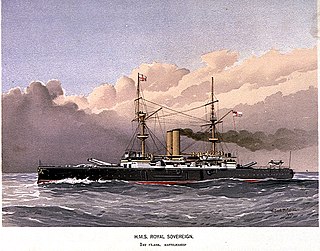
Pre-dreadnought battleships were sea-going battleships built from the mid- to late- 1880s to the early 1900s. Their designs were conceived before the appearance of HMS Dreadnought in 1906 and their classification as "pre-dreadnought" is retrospectively applied. In their day, they were simply known as "battleships" or else more rank-specific terms such as "first-class battleship" and so forth. The pre-dreadnought battleships were the pre-eminent warships of their time and replaced the ironclad battleships of the 1870s and 1880s.

The New York class was a pair of super-dreadnought battleships built for the United States Navy between 1911 and 1914. The two ships of the class, New York and Texas, saw extensive service beginning in the occupation of Veracruz, World War I, and World War II.

The Radetzky class was a group of three semi-dreadnought battleships built for the Austro-Hungarian Navy between 1907 and 1910. All ships were built by the STT shipyard in Trieste. They were the last pre-dreadnoughts built by the Austro-Hungarians, and the penultimate class of any type of Austro-Hungarian battleship completed. The class comprised three ships: Radetzky, Erzherzog Franz Ferdinand, and Zrínyi. They were armed with four 30.5-centimeter (12.0 in) guns in two twin turrets and eight 24 cm (9.4 in) guns in four twin turrets.

España was a Spanish dreadnought battleship, the lead ship of the España class, the two other ships being Alfonso XIII and Jaime I. The ship was built in the early 1910s in the context of a cooperative defensive agreement with Britain and France, as part of a naval construction program to restore the fleet after the losses of the Spanish–American War. She was the only member of the class to be completed before the start of World War I, which significantly delayed completion of the other vessels. The ships were armed with a main battery of eight 305 mm (12 in) guns and were intended to support the French Navy in the event of a major European war.

Démocratie was a pre-dreadnought battleship built for the French Navy in the mid-1900s. She was the fourth member of the Liberté class, which included three other vessels and was a derivative of the preceding République class, with the primary difference being the inclusion of a heavier secondary battery. Démocratie carried a main battery of four 305 mm (12 in) guns, like the République, but mounted ten 194 mm (7.6 in) guns for her secondary armament in place of the 164 mm (6.5 in) guns of the earlier vessels. Like many late pre-dreadnought designs, Démocratie was completed after the revolutionary British battleship HMS Dreadnought had entered service, rendering her obsolescent.
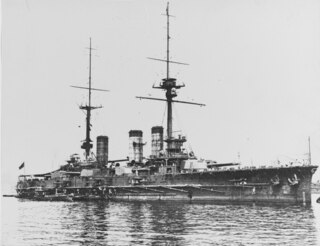
The Satsuma class was a pair of semi-dreadnought battleships built for the Imperial Japanese Navy (IJN) in the first decade of the 20th century. They were the first battleships to be built in Japan and marked a transitional stage between the pre-dreadnought and true dreadnought designs. They saw no combat during World War I, although Satsuma led a squadron that occupied several German colonies in the Pacific Ocean in 1914. Both ships were disarmed and expended as targets in 1922–1924 in accordance with the terms of the Washington Naval Treaty of 1922.

République was a pre-dreadnought battleship, the lead vessel of the République class built for the French Navy built in the early 1900s. Laid down in December 1901, she was launched in September 1902 and commissioned in January 1907. Armed with a main battery of four 305 mm (12.0 in) guns, she was outclassed before even entering service by the revolutionary British battleship HMS Dreadnought, that had been commissioned the previous December and was armed with a battery of ten guns of the same caliber. Though built to an obsolescent design, République proved to be a workhorse of the French fleet, particularly during World War I.

The République class consisted of a pair of pre-dreadnought battleships—République, the lead ship, and Patrie—built for the French Navy in the early 1900s. They were ordered as part of a naval expansion program directed at countering German warship construction authorized by the German Naval Law of 1898. The French program called for six new battleships; the last four became the very similar Liberté class. République and Patrie, designed by Louis-Émile Bertin, were a significant improvement over previous French battleships. They carried a similar offensive armament of four 305 mm (12 in) guns and eighteen 164 mm (6.5 in) guns, though most of the 164 mm guns were now mounted in more flexible gun turrets rather than in casemates. They also had a much more effective armor protection arrangement that remedied the tendency of earlier battleships to lose stability from relatively minor damage.
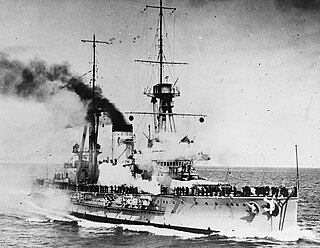
Alfonso XIII was the second of three España-class dreadnought battleships built in the 1910s for the Spanish Navy. Named after King Alfonso XIII of Spain, the ship was not completed until 1915 owing to a shortage of materials that resulted from the start of World War I the previous year. The España class was ordered as part of a naval construction program to rebuild the fleet after the losses of the Spanish–American War; the program began in the context of closer Spanish relations with Britain and France. The ships were armed with a main battery of eight 305 mm (12 in) guns and were intended to support the French Navy in the event of a major European war.

Jaime I was a Spanish dreadnought battleship, the third and final member of the España class, which included two other ships: España and Alfonso XIII. Named after King James I of Aragon, Jaime I was built in the early 1910s, though her completion was delayed until 1921 owing to a shortage of materials that resulted from the start of World War I in 1914. The class was ordered as part of a naval construction program to rebuild the fleet after the losses of the Spanish–American War in the context of closer Spanish relations with Britain and France. The ships were armed with a main battery of eight 305 mm (12 in) guns and were intended to support the French Navy in the event of a major European war.

L 20e α was a design for a class of battleships to be built in 1918 for the German Kaiserliche Marine during World War I. Design work on the class of battleship to succeed the Bayern-class battleships began in 1914, but the outbreak of World War I in July 1914 led to these plans being shelved. Work resumed in early 1916 and lessons from the Battle of Jutland, fought later that year, were incorporated into the design. Reinhard Scheer, the commander of the fleet, wanted larger main guns and a higher top speed than earlier vessels, to combat the latest ships in the British Royal Navy. A variety of proposals were submitted, with armament ranging from the same eight 38 cm (15 in) guns of the Bayern class to eight 42 cm (16.5 in) guns.

Spain remained neutral throughout World War I between 28 July 1914 and 11 November 1918, and despite domestic economic difficulties, it was considered "one of the most important neutral countries in Europe by 1915". Spain had maintained a non-aligned stance during the political difficulties of pre-war Europe, and continued its neutrality after the war until the Spanish Civil War began in 1936. While there was no direct military involvement in the war, German forces were interned in Spanish Guinea in late 1915.
The Reina Victoria Eugenia class was a class of three battleships of the Spanish Navy authorized as the Plan de la Segunda Escuadra under the Navy Law of 1913. The class, as well as the lead ship, were named for King Alfonso XIII's English queen consort, Victoria Eugenie of Battenberg. The other two ships were classified as "B" and "C". It was supposed to be designed by Vickers-Armstrongs, and built by John Brown. The ships were never built due to Britain's involvement in World War I, which halted all foreign projects being constructed in British yards.

Reina Regente was a protected cruiser built for the Spanish Navy in the 1900s, the only member of her class. She had a very lengthy construction period, being laid down in 1899, launched in 1906, and finally completed in 1908. The last cruiser built in Spain for nearly twenty years, she was armed with a battery of ten 15 cm (5.9 in) guns and was capable of a top speed of 20 knots. Reina Regente's career was uneventful, the result of limited naval budgets and Spain's neutrality during World War I. In the early 1920s, she was employed as a training ship until she was discarded in 1926.


